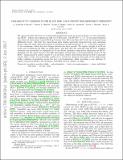Variable H13CO+ Emission in the IM Lup Disk: X-Ray Driven Time-dependent Chemistry?
Citation
Cleeves, L. Ilsedore, Edwin A. Bergin, Karin I. Öberg, Sean Andrews, David Wilner, and Ryan Loomis. 2017. Variable H 13 CO Emission in the IM Lup Disk: X-Ray Driven Time-dependent Chemistry? The Astrophysical Journal Letters 843, no. 1: 7.Abstract
We report the first detection of a substantial brightening event in an isotopologue of a key molecular ion, HCO+, within a protoplanetary disk of a T Tauri star. The H13CO+ $J=3-2$ rotational transition was observed three times toward IM Lup between 2014 July and 2015 May with the Atacama Large Millimeter/submillimeter Array. The first two observations show similar spectrally integrated line and continuum fluxes, while the third observation shows a doubling in the disk-integrated $J=3-2$ line flux compared to the continuum, which does not change between the three epochs. We explore models of an X-ray active star irradiating the disk via stellar flares, and find that the optically thin H13CO+ emission variation can potentially be explained via X-ray-driven chemistry temporarily enhancing the HCO+ abundance in the upper layers of the disk atmosphere during large or prolonged flaring events. If the HCO+ enhancement is indeed caused by an X-ray flare, future observations should be able to spatially resolve these events and potentially enable us to watch the chemical aftermath of the high-energy stellar radiation propagating across the face of protoplanetary disks, providing a new pathway to explore ionization physics and chemistry, including electron density, in disks.Terms of Use
This article is made available under the terms and conditions applicable to Open Access Policy Articles, as set forth at http://nrs.harvard.edu/urn-3:HUL.InstRepos:dash.current.terms-of-use#OAPCitable link to this page
http://nrs.harvard.edu/urn-3:HUL.InstRepos:41024545
Collections
- FAS Scholarly Articles [18292]
Contact administrator regarding this item (to report mistakes or request changes)



